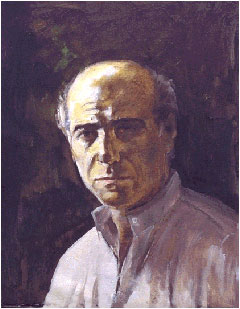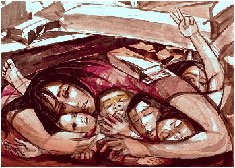Amdist the ongoing Gaza attack, which has converted Gaza into hell-land (my cousins today told me they are only getting one hour of elctricity a day, IF they are lucky...) a Palestinian treasure has left us. Famed Palestinian artist Ismail Shammout passed away on July 4. He was argulably one of the most influential Palestinian artists and most experssive of the Palestinia psyche. A bio follows-worth the read, especially for those not familiar with his work (it can be accessed on www.shammout.com).

"Self Portrait", 1985
Interstingly, Shammout actually taught my mother art in Khan Yunis when she was growing up (actually they got private lessons from him!), where he was forced to flee at a young age from his native Lydd at gunpoint by Israeli terrorist gangs. She remembers him as a patient, kindred spirit. May he rest in peace.
(bio by U.S. based Palestinian artist Samia Halaby)
Ismail Shammout died July 4. How painful that Palestine was not there
around his bed; but all he worked for our lives.

"The Olive Tree", 2005
Born in Al-Lydd in 1931, Ismail Shammout had the good fortune as a youth to
study with Dahoud Zalatimo. Remarkably, at the age sixteen he persuaded his
reluctant father that he could earn a living making art. His father, even
more amazingly, provided him with materials and a space to work. It was then
1947, only one year before the Nakbe.
Shammout was seventeen when on July 13, 1948, he was evicted from his home
along with the majority of the population of Al Lydd. They were ordered at
gunpoint to leave their homes, surrounded by armed Zionist gangs and overseen
by sharpshooters on roofs. They were herded into the town squares and thence
forced eastwards into the wilderness. On the way, they were molested by
Zionist thugs who at gunpoint stole their valuables and confiscated the little
water or food some of them had. The painful march took three to five days to
complete. Many perished. With his family, he ended up in the refugee camp of
Khan Younis where he painted the suffering of women and children, and the
agonies of long lines for food and water. Shammout organized his first exhibit
in 1950 in this very refugee camp.
Shammout's career as an artist and popular hero of Palestine began with his
1953 exhibition of oil paintings in Gaza of the catastrophic march through
wilderness. The exhibited paintings objectify and socialize a pain that had
simmered on a private level. Refugees in Gaza saw themselves reflected in
Shammout's work and felt relief. An immense attendance of the general
population in Gaza, including those living in refugee camps, overwhelmed Shammout,
then studying in Egypt. This stunning response to the show was a hint of the
bottled up hope for liberation. In response, Shammout committed his life's
work to Palestine and the art of liberation.
His life and that of his wonderful wife Tamam Al-Akhal, spiraled around
Palestine. With every move forced on them by Zionist aggression, they relocated
somewhere not far from the center of their love. This denied center of the
heart, Palestine, was finally visited years after the Nakbe. Of the many
people who remember this visit, a most touching one was a description of Shammout
meeting with Zalatimo, his first teacher and inspiration. In June of 2002,
Fadwa Zalatimo, daughter of the great artists Dahoud Zalatimo, said to me
that when Zalatimo was near death, 47 years after their involuntary separation,
Shammout traveled to Jerusalem to visit Zalatimo. She remembers it as an
event of great emotion. "It was mutual admiration between them," said Fadwa.
"They -- Ismail and Zalatimo -- met after the long separation. He [Shammout]
kissed his hands and thanked him and they both cried."
"Tel Al-Zaater 1976, in Shelter", 1976


"For the Coming Joy", 1987
Shammout’s studio was the place we went to as one goes to the source, a
wealth of information and documents, a place of quiet, a place for thought and
art, a place of gentleness, and above all a cultural storehouse of Palestine.
Shammout is the builder of the Union of Palestinian artists, the builder of
international exhibitions, the builder of young artists, the builder of
galleries, and not least of all the historian of the liberation movement of
Palestinian art.
He lives in my memories as that tall young man with intense eyes whom I
first met in 1979 on the streets of Beirut. An image of night black hair flying
in its own revolution impressed visually his intense message on my
thourghts. Now that he is gone, the burden of his legacy weighs on all Palestinian
artists, as we too shoulder the art and culture of Palestine, though we are
scattered and suffering news of the latest attacks on Shammout's Gaza.

"Self Portrait", 1985
Interstingly, Shammout actually taught my mother art in Khan Yunis when she was growing up (actually they got private lessons from him!), where he was forced to flee at a young age from his native Lydd at gunpoint by Israeli terrorist gangs. She remembers him as a patient, kindred spirit. May he rest in peace.
(bio by U.S. based Palestinian artist Samia Halaby)
Ismail Shammout died July 4. How painful that Palestine was not there
around his bed; but all he worked for our lives.

"The Olive Tree", 2005
Born in Al-Lydd in 1931, Ismail Shammout had the good fortune as a youth to
study with Dahoud Zalatimo. Remarkably, at the age sixteen he persuaded his
reluctant father that he could earn a living making art. His father, even
more amazingly, provided him with materials and a space to work. It was then
1947, only one year before the Nakbe.
Shammout was seventeen when on July 13, 1948, he was evicted from his home
along with the majority of the population of Al Lydd. They were ordered at
gunpoint to leave their homes, surrounded by armed Zionist gangs and overseen
by sharpshooters on roofs. They were herded into the town squares and thence
forced eastwards into the wilderness. On the way, they were molested by
Zionist thugs who at gunpoint stole their valuables and confiscated the little
water or food some of them had. The painful march took three to five days to
complete. Many perished. With his family, he ended up in the refugee camp of
Khan Younis where he painted the suffering of women and children, and the
agonies of long lines for food and water. Shammout organized his first exhibit
in 1950 in this very refugee camp.
Shammout's career as an artist and popular hero of Palestine began with his
1953 exhibition of oil paintings in Gaza of the catastrophic march through
wilderness. The exhibited paintings objectify and socialize a pain that had
simmered on a private level. Refugees in Gaza saw themselves reflected in
Shammout's work and felt relief. An immense attendance of the general
population in Gaza, including those living in refugee camps, overwhelmed Shammout,
then studying in Egypt. This stunning response to the show was a hint of the
bottled up hope for liberation. In response, Shammout committed his life's
work to Palestine and the art of liberation.
His life and that of his wonderful wife Tamam Al-Akhal, spiraled around
Palestine. With every move forced on them by Zionist aggression, they relocated
somewhere not far from the center of their love. This denied center of the
heart, Palestine, was finally visited years after the Nakbe. Of the many
people who remember this visit, a most touching one was a description of Shammout
meeting with Zalatimo, his first teacher and inspiration. In June of 2002,
Fadwa Zalatimo, daughter of the great artists Dahoud Zalatimo, said to me
that when Zalatimo was near death, 47 years after their involuntary separation,
Shammout traveled to Jerusalem to visit Zalatimo. She remembers it as an
event of great emotion. "It was mutual admiration between them," said Fadwa.
"They -- Ismail and Zalatimo -- met after the long separation. He [Shammout]
kissed his hands and thanked him and they both cried."
"Tel Al-Zaater 1976, in Shelter", 1976


"For the Coming Joy", 1987
Shammout’s studio was the place we went to as one goes to the source, a
wealth of information and documents, a place of quiet, a place for thought and
art, a place of gentleness, and above all a cultural storehouse of Palestine.
Shammout is the builder of the Union of Palestinian artists, the builder of
international exhibitions, the builder of young artists, the builder of
galleries, and not least of all the historian of the liberation movement of
Palestinian art.
He lives in my memories as that tall young man with intense eyes whom I
first met in 1979 on the streets of Beirut. An image of night black hair flying
in its own revolution impressed visually his intense message on my
thourghts. Now that he is gone, the burden of his legacy weighs on all Palestinian
artists, as we too shoulder the art and culture of Palestine, though we are
scattered and suffering news of the latest attacks on Shammout's Gaza.










0 коммент.:
Speak up your mind
Tell us what you're thinking... !